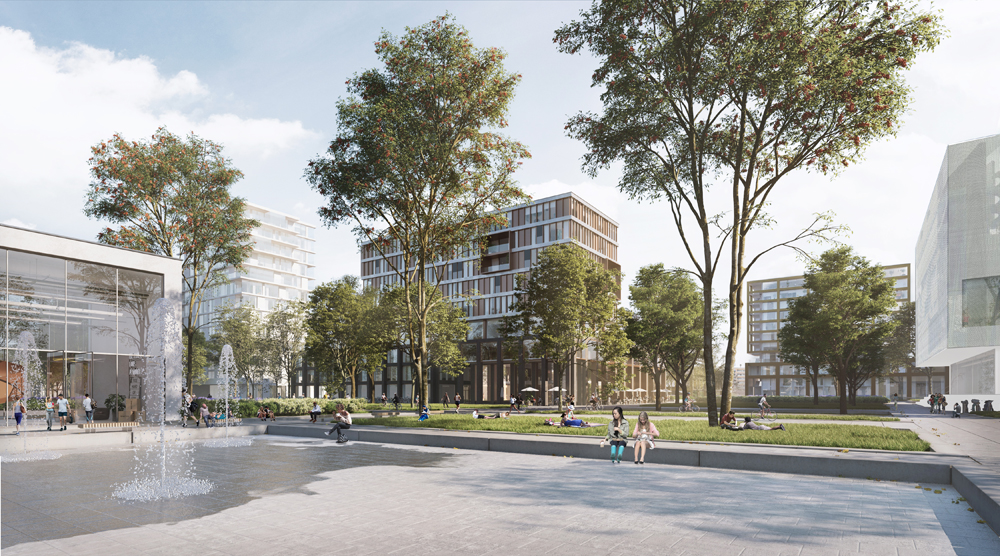MORE
Leiden (NL), 2026
10 September 2021 | News
We want MORE! Celebrating the start of construction of Park MORE, Bio Science Park Leiden
Information
Designing for a healthy campus environment that promotes interaction and knowledge exchange
MORE is destined to become the buzzing nucleus of Leiden Bio Science Park, an international campus that promotes social interaction and knowledge exchange. In this new urban ecosystem, new and existing buildings, infrastructure and landscape, people, wildlife and plants will all work in harmony. Thanks to our implementation of the microcity concept, MORE will be partly self-sufficient, thereby reducing the pressure on external infrastructure and the environment to a significant extent.
Design questions and opportunities
The new entrance area, an initiative by Yisheng Development, presents a wonderful opportunity to create an extraordinary location and add value to the city of Leiden. VenhoevenCS and Paul de Ruiter are collaborating to develop an area where co-working spaces, large open outdoor areas, green oases and courtyard gardens ensure that campus life amounts to more than just studying, conducting research and living.
The questions that preoccupied us at the design phase were: “How do you ensure that expats who are in Leiden for only a short while feel welcome from the moment they arrive and are quickly integrated into the community? How do you make an 18-year-old student who has left his parents’ warm nest for the very first time feel at home in the entrance area? How do you make this area an inseparable part of the city, and how do you create a close-knit community from an international collection of students, teachers, expats and Leiden residents?”
A vibrant campus community
The answer is MORE, a name that refers both to the utopian ideas of the 16th-century philosopher and statesman Thomas More and to the shared ambitions of this plan. MORE comprises roughly 1,200 rental homes and a hotel, mainly intended for students, young professionals, and local and international university staff. The mix of shared facilities and communal areas, within the buildings as well as in the park and on roof terraces, will help foster a vibrant community of students and campus residents that other Leiden locals and workers will also find appealing.
Space, daylight and fresh air
Thermal comfort and general habitat-related wellbeing depend a great deal on how much daylight, fresh air and space we have access to, so our design prioritises daylight admission, air quality via year-round natural ventilation and heat recovery in winter, and underfloor heating. The campus will be largely car-free, and homes close to the busy Plesmanlaan will come with sound-absorbing facades. Finally, buildings will be oriented in a way that creates microclimates beneficial to the wellbeing of not only people, but also flora and fauna.
A green environment for living, working and studying
Buildings and passages will be distinguished by subtle changes in height, fine detailing and a careful selection of trees and plants. Outdoor spaces will be distinguished by colour, achieved by our selection of building materials and plants. Our criteria for selecting plants and trees include seasonal properties (flowering, fruiting and autumnal colours), texture, water-purifying properties, and attraction for birds, insects and other wildlife. The third-floor roof consists of terraces and treed gardens, while greenhouses on the roof terraces allow residents to engage in small-scale urban agriculture. Sedum plants and solar panels will cover the highest roofs.
MORE is to be a nature-inclusive entrance area, which means it will include an abundance of all sorts of plants and trees and lots of flowing water, providing an environment for birds, fish and other wildlife to thrive. The lower floors will enjoy extra room for façade vegetation, which will allow a healthy ecosystem to develop and thereby render insecticides and pesticides superfluous. The communal gardens and roof gardens will be open to everyone. Working, studying and living amid natural surroundings contributes immensely to our health and wellbeing; it reduces stress and encourages us to exercise, play and interact more. It also makes the campus a more vibrant and pleasant place.
Three-storey plinth-like base for socializing, vibrancy and safety
Interaction will be a constant feature of campus life, day and night and throughout the weekends, and MORE’s three-storey plinth-like base is designed to facilitate this. This base will accommodate a mix of sports clubs, restaurants, and work and study areas, as well as functional areas such as lobbies and entryways to bicycle parking facilities.
Related News & MediaStatistics
| Name: | MORE |
| Location: | BioScience Park, Leiden (NL) |
| Program: | MicroCity: housing and community facilities |
| Surface area: | 67,250 m2 |
| Assignment: | Master Plan; Competition design; Concept design; Schematic design; Design Development; Construction documents; Construction administration |
| Period: | 2017-2023 |
| Status: | In Progress |
| Client: | Yisheng Development, Lingotto |
Credits
| VenhoevenCS: | Ton Venhoeven, Manfred Wansink, Hermen Jansen, Max Fleer, Arjan Pot, Grzegorz Balinski, Hans Kooij, Sara Ozcan |
| Partner architect: | Paul de Ruiter Architects |
| Developer: | Yisheng Development, Lingotto, RED+, Realnomics |
| Landscape architect: | Landlab |
| Main contractor: | Heddes Bouw & Ontwikkeling |
| Structural engineer: | IMd |
| MEP: | TRAJECT |
| Building physics: | Peutz |
| Project management: | RED+ |
| Cost consultant: | RHDHV |
| Images: | A2 Studio (renders) |










